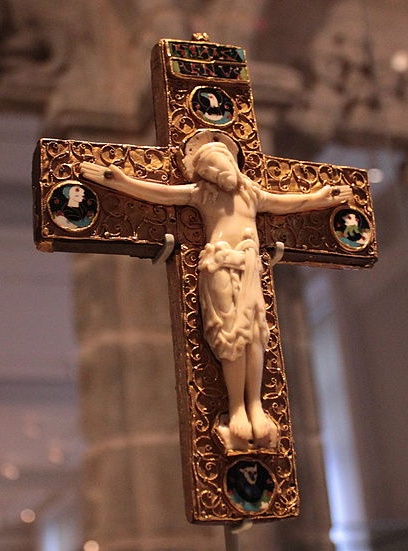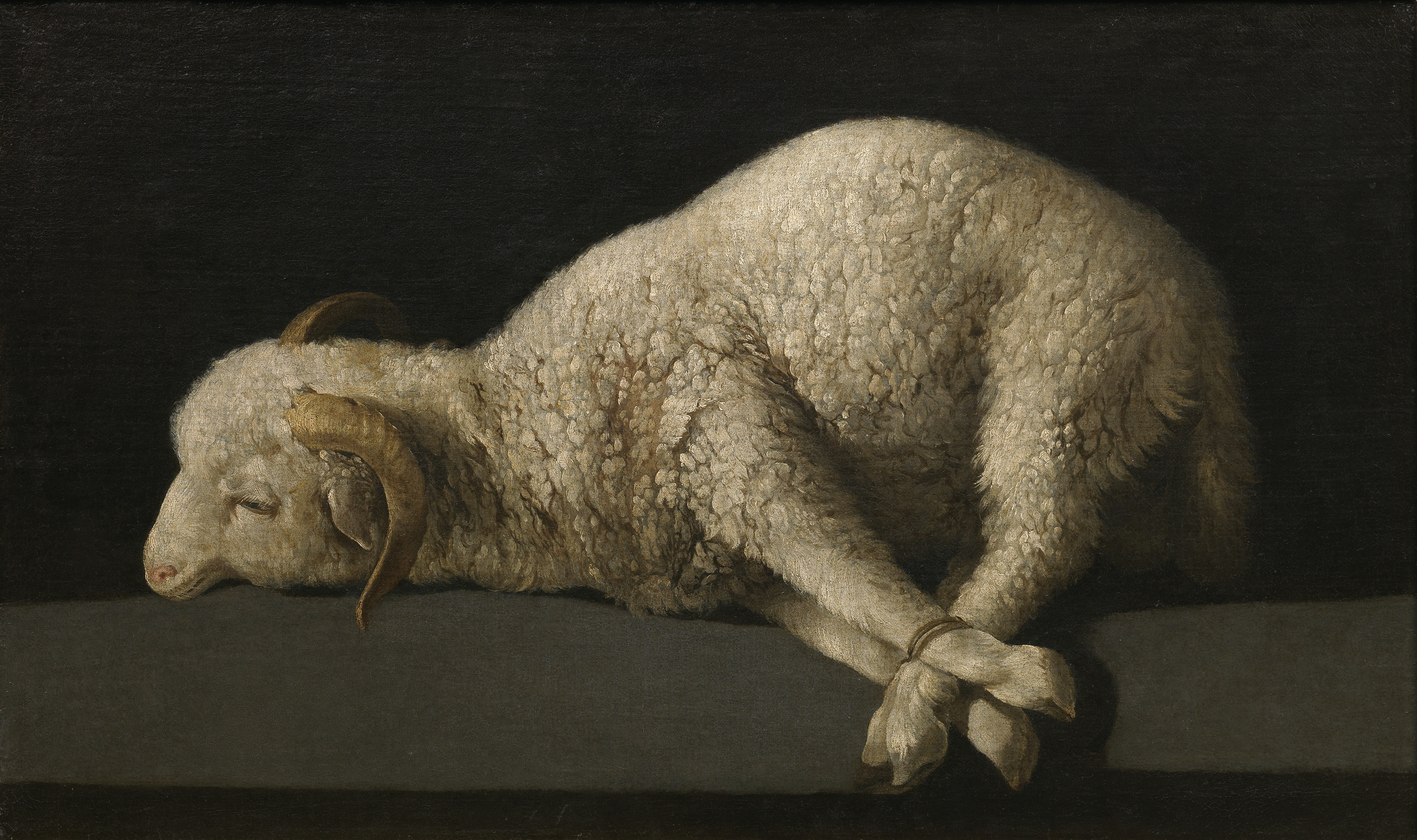|
Anglo-Saxon Reliquary Cross
The Reliquary Cross is a late 10th-century Anglo-Saxon ivory figure of Christ, set on an earlier Ottonian cross to make a reliquary in the form of a crucifix. It is in the Victoria and Albert Museum (V&A) in London (Cat. 7943-1862, usually on display in room 8, case 16, in the "Medieval and Renaissance" gallery).V&A The cross is made of cedar wood and covered with plates of gold filigree work. The ''corpus'' or figure of Christ, was probably made in Winchester, and is in walrus ivory; the titulus and medallions are in cloisonné enamel, and apparently also English. The body of the reliquary, because of a technical "trick" in the gold filigree, is thought to be German, around the same date, probably from the area of Aachen and Essen. The V&A says "the cross is one of the rare surviving pieces which give substance to descriptions in contemporary documentary sources of the sumptuous church furnishings of pre-Conquest England. The enamels are unique in Anglo-Saxon art and may hav ... [...More Info...] [...Related Items...] OR: [Wikipedia] [Google] [Baidu] |
BLW Reliquary Cross Crop
BLW or blw may refer to: * Baby-led weaning, an approach to adding complementary foods to a baby's diet of breast milk or formula * Baldwin Locomotive Works, a defunct American manufacturer of railroad locomotives * BLW, the IATA code for Beledweyne Airport, Somalia * BLW, the Indian Railways station code for Balawali railway station, Uttar Pradesh, India * blw, the ISO 639-3 code for Balangao language, Luzon, Philippines {{Disambiguation ... [...More Info...] [...Related Items...] OR: [Wikipedia] [Google] [Baidu] |
Relic
In religion, a relic is an object or article of religious significance from the past. It usually consists of the physical remains of a saint or the personal effects of the saint or venerated person preserved for purposes of veneration as a tangible memorial. Relics are an important aspect of some forms of Buddhism, Christianity, Islam, shamanism, and many other religions. ''Relic'' derives from the Latin ''reliquiae'', meaning "remains", and a form of the Latin verb ''relinquere'', to "leave behind, or abandon". A reliquary is a shrine that houses one or more religious relics. In classical antiquity In ancient Greece, a polis, city or Greek temple, sanctuary might claim to possess, without necessarily displaying, the remains of a venerated hero as a part of a Greek hero cult, hero cult. Other venerable objects associated with the hero were more likely to be on display in sanctuaries, such as spears, shields, or other weaponry; chariots, ships or Figurehead (object), figureheads ... [...More Info...] [...Related Items...] OR: [Wikipedia] [Google] [Baidu] |
Ivory Works Of Art
Ivory is a hard, white material from the tusks (traditionally from elephants) and teeth of animals, that consists mainly of dentine, one of the physical structures of teeth and tusks. The chemical structure of the teeth and tusks of mammals is the same, regardless of the species of origin, but ivory contains structures of mineralised collagen. The trade in certain teeth and tusks other than elephant is well established and widespread; therefore, "ivory" can correctly be used to describe any mammalian teeth or tusks of commercial interest which are large enough to be carved or scrimshawed. Besides natural ivory, ivory can also be produced synthetically, hence (unlike natural ivory) not requiring the retrieval of the material from animals. Tagua nuts can also be carved like ivory. The trade of finished goods of ivory products has its origins in the Indus Valley. Ivory is a main product that is seen in abundance and was used for trading in Harappan civilization. Finished ivory pr ... [...More Info...] [...Related Items...] OR: [Wikipedia] [Google] [Baidu] |
Ramsey Psalter
The Psalter of Oswald also called the Ramsey Psalter (British Library, Harley MS 2904) is an Anglo-Saxon illuminated psalter of the last quarter of the tenth century. Its script and decoration suggest that it was made at Winchester, but certain liturgical features have suggested that it was intended for use at the Benedictine monastery of Ramsey Abbey, or for the personal use of Ramsey's founder St Oswald. The litany includes a gold-lettered triple invocation of St Benedict of Nursia, and at the time of writing, probably before Oswald's death in 992, Ramsey was the only English monastery dedicated to this saint. A "Psalter of St Oswald" was listed in a 14th-century catalogue of the library at Ramsey. This manuscript is not to be confused with another Ramsey Psalter in the Morgan Library & Museum, New York (MS M. 302), made between 1286 and 1316. The text is a Latin psalter using the Gallican version. The "elegant English caroline minuscule" of the script inspired the influ ... [...More Info...] [...Related Items...] OR: [Wikipedia] [Google] [Baidu] |
David M
David (; , "beloved one") (traditional spelling), , ''Dāwūd''; grc-koi, Δαυΐδ, Dauíd; la, Davidus, David; gez , ዳዊት, ''Dawit''; xcl, Դաւիթ, ''Dawitʿ''; cu, Давíдъ, ''Davidŭ''; possibly meaning "beloved one". was, according to the Hebrew Bible, the third king of the United Kingdom of Israel. In the Books of Samuel, he is described as a young shepherd and harpist who gains fame by slaying Goliath, a champion of the Philistines, in southern Canaan. David becomes a favourite of Saul, the first king of Israel; he also forges a notably close friendship with Jonathan, a son of Saul. However, under the paranoia that David is seeking to usurp the throne, Saul attempts to kill David, forcing the latter to go into hiding and effectively operate as a fugitive for several years. After Saul and Jonathan are both killed in battle against the Philistines, a 30-year-old David is anointed king over all of Israel and Judah. Following his rise to power, David ... [...More Info...] [...Related Items...] OR: [Wikipedia] [Google] [Baidu] |
Mary Magdalene
Mary Magdalene (sometimes called Mary of Magdala, or simply the Magdalene or the Madeleine) was a woman who, according to the four canonical gospels, traveled with Jesus as one of his followers and was a witness to crucifixion of Jesus, his crucifixion and Resurrection of Jesus, resurrection. She is mentioned by name twelve times in the canonical gospels, more than most of the Apostles in the New Testament, apostles and more than any other woman in the gospels, other than Jesus' family. Mary's epithet ''Magdalene'' may mean that she came from the town of Magdala, a fishing town on the western shore of the Sea of Galilee in Roman Judea. The Gospel of Luke Luke 8, chapter 8 lists Mary Magdalene as one of the women who traveled with Jesus and helped support his ministry "out of their resources", indicating that she was probably wealthy. The same passage also states that seven demons Exorcism, had been driven out of her, a statement which is repeated in Mark 16. In all the four can ... [...More Info...] [...Related Items...] OR: [Wikipedia] [Google] [Baidu] |
Exeter
Exeter () is a city in Devon, South West England. It is situated on the River Exe, approximately northeast of Plymouth and southwest of Bristol. In Roman Britain, Exeter was established as the base of Legio II Augusta under the personal command of Vespasian. Exeter became a religious centre in the Middle Ages. Exeter Cathedral, founded in the mid 11th century, became Anglican in the 16th-century English Reformation. Exeter became an affluent centre for the wool trade, although by the First World War the city was in decline. After the Second World War, much of the city centre was rebuilt and is now a centre for education, business and tourism in Devon and Cornwall. It is home to two of the constituent campuses of the University of Exeter: Streatham and St Luke's. The administrative area of Exeter has the status of a non-metropolitan district under the administration of the County Council. It is the county town of Devon and home to the headquarters of Devon County Council. A p ... [...More Info...] [...Related Items...] OR: [Wikipedia] [Google] [Baidu] |
Exeter Monastery
St Nicholas' Priory, Exeter, the remains of part of a Benedictine monastery. Various monasteries and other religious houses have existed at various times during the Middle Ages in the city of Exeter, Devon, England. The Monastic buildings included: ;Anglo-Saxon foundations * Exeter Cathedral Priory, possibly founded before circa 690 * The Saxon Monastery, founded by King Æthelred of Wessex in 868 * The Benedictine Monastery, founded in 932 by King Æthelstan and dedicated to Saint Mary and Saint Peter * The Nunnery of Saint Augustine, a nunnery of Augustinian Canonesses founded circa 968 ;Norman and later foundations * The Benedictine Priory of St Nicholas, a Benedictine monastery founded in 1087 * St James Priory, a Cluniac priory founded in 1146 * Polsloe Priory, a Benedictine priory for women (a nunnery) founded circa 1159 * Exeter Blackfriars, a Dominican friary founded before 1232 * Exeter Grey Friary, a Franciscan friary founded before 1240 * Exeter Priory, a Cart ... [...More Info...] [...Related Items...] OR: [Wikipedia] [Google] [Baidu] |
Lamb Of God
Lamb of God ( el, Ἀμνὸς τοῦ Θεοῦ, Amnòs toû Theoû; la, Agnus Dei, ) is a title for Jesus that appears in the Gospel of John. It appears at John 1:29, where John the Baptist sees Jesus and exclaims, "Behold the Lamb of God who takes away the sin of the world." It appears again in John 1:36. Christian doctrine holds that a divine Jesus chose to suffer crucifixion at Calvary as a sign of his full obedience to the will of his divine Father, as an "agent and servant of God" in carrying away the sins of the world. In Christian theology the ''Lamb of God'' is viewed as both foundational and integral to the message of Christianity. A lion-like lamb that rises to deliver victory after being slain appears several times in the Book of Revelation. It is also referred to in Pauline writings; 1 Corinthians 5:7 suggests that Saint Paul intends to refer to the death of Jesus, who is the Paschal Lamb, using the theme found in Johannine writings. In Genesis 22, the bindi ... [...More Info...] [...Related Items...] OR: [Wikipedia] [Google] [Baidu] |
Pectoral Cross
A pectoral cross or pectorale (from the Latin ''pectoralis'', "of the chest") is a cross that is worn on the chest, usually suspended from the neck by a cord or chain. In ancient and medieval times pectoral crosses were worn by both clergy and laity, but by the end of the Middle Ages the pectoral cross came to be a special indicator of position worn by bishops. In the Roman Catholic Church, the wearing of a pectoral cross remains restricted to popes, cardinals, bishops and abbots. In Eastern Orthodox Church and Byzantine Catholic Churches that follow a Slavic Tradition, priests also wear pectoral crosses, while deacons and minor orders do not. The modern pectoral cross is relatively large, and is different from the small crosses worn on necklaces by many Christians. Most pectoral crosses are made of precious metals (platinum, gold or silver) and some contain precious or semi-precious gems. Some contain a corpus like a crucifix while others use stylized designs and religious s ... [...More Info...] [...Related Items...] OR: [Wikipedia] [Google] [Baidu] |








